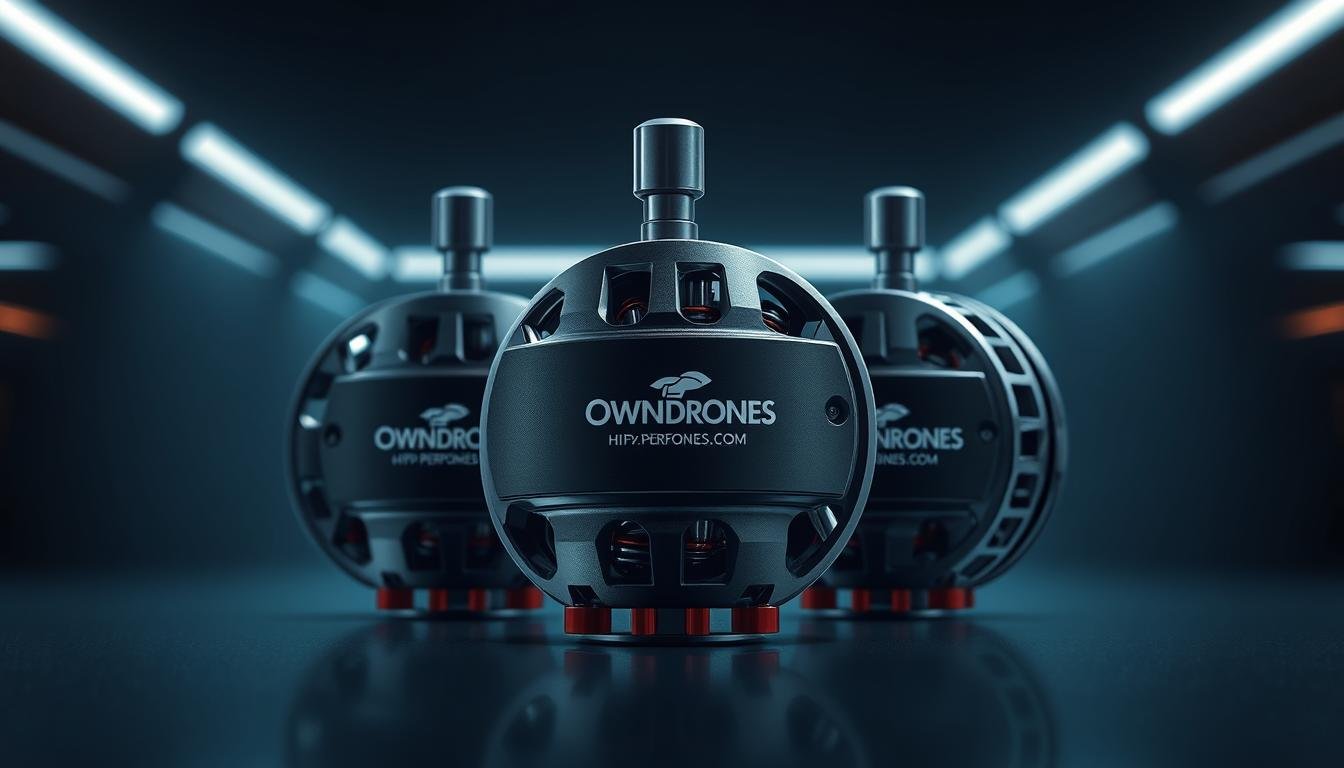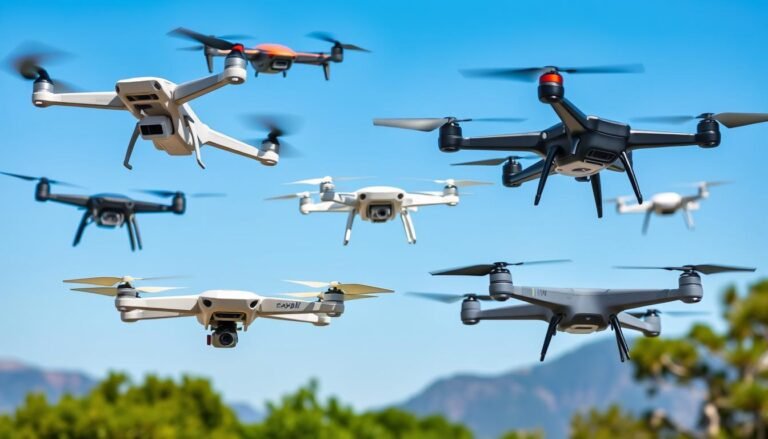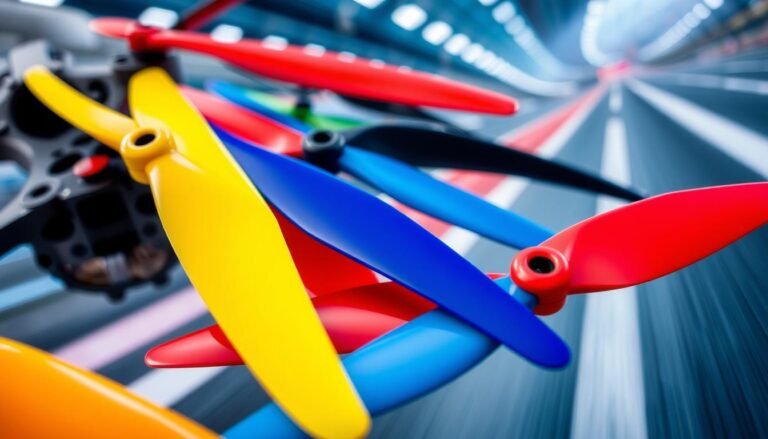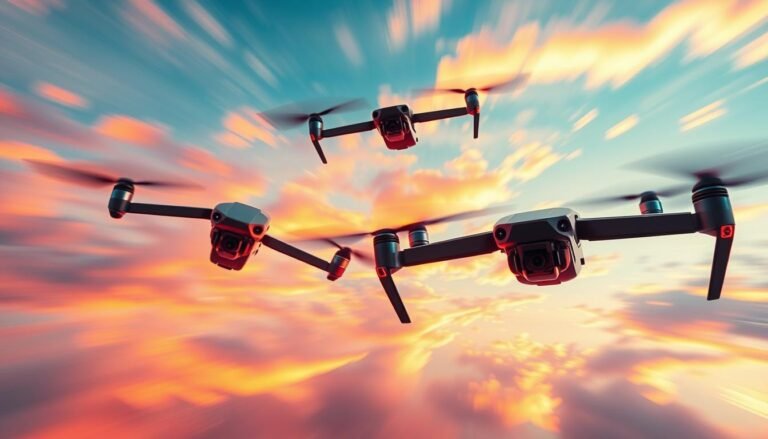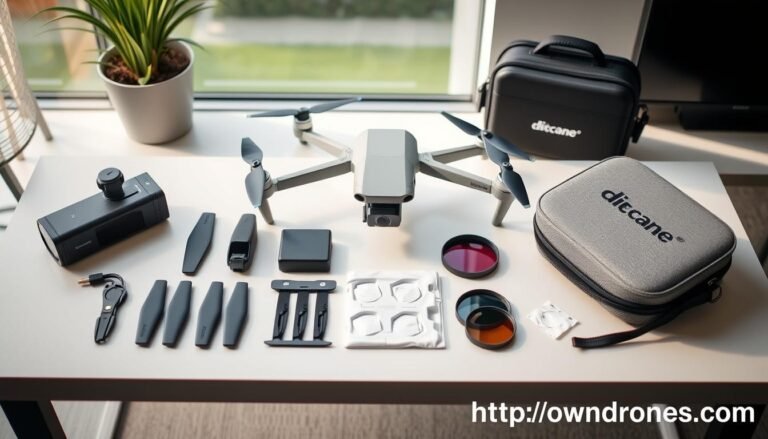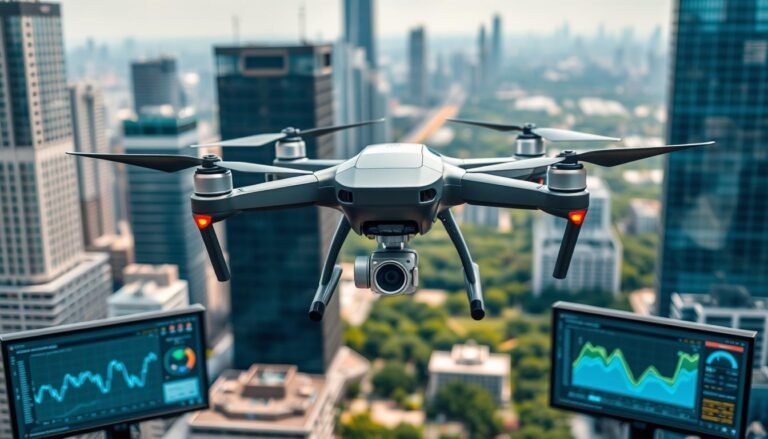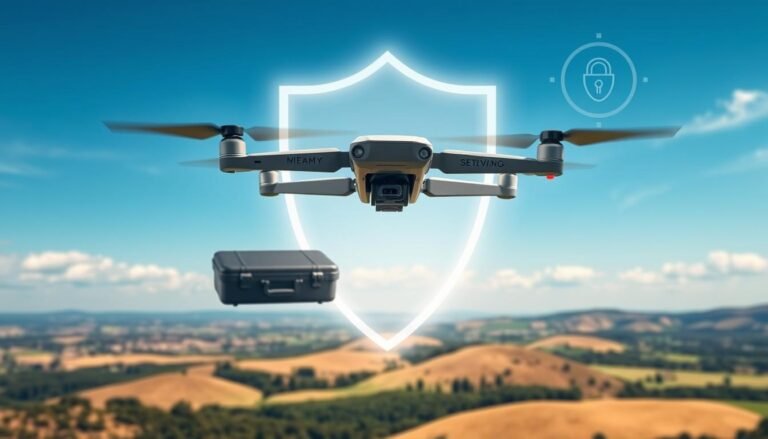Guide to Choosing the Best Drone Motors for Your UAV
Finding the right motors for your drone can be tough. Many options exist, making it hard to pick the best ones. The right motors are key for optimal flight and reliability.
This guide explores drone motors in depth. We’ll look at types, specs, and factors to consider. You’ll learn about brushed vs. brushless motors, KV ratings, and more.
We’ll cover new drone motor tech too. Top motors from T-MOTOR, SUPER-E, Plettenberg, and MGM COMPRO will be featured. This guide helps you find perfect motors for upgrades or new builds.
Key Takeaways
- Brushless motors are more efficient, durable, and powerful than brushed motors, making them the preferred choice for modern drones.
- The KV rating determines a motor’s speed at a given voltage, with lower KV motors providing more torque and higher KV motors offering greater speed.
- Motors with higher pole and magnet counts generally offer smoother operation, better torque, and increased thrust, benefiting stability and payload capacity.
- Voltage and current requirements impact motor selection and battery pairing, affecting RPM, power output, torque, and responsiveness.
- Propeller size affects motor performance, with larger props requiring more torque and smaller props matching high-KV motors for speed.
Understanding the Types of Drone Motors
Drone motors come in two main types: brushed and brushless. These motors are vital for a drone’s performance and efficiency. Let’s explore the differences between these two types.
Brushed Motors: Structure, Operation, and Performance
Brushed motors are simple and cost-effective. They have a rotor, windings, commutator, and brushes. The brushes contact the commutator as the rotor spins, creating torque.
These motors are easy to repair but have some drawbacks. They’re less efficient and have a shorter lifespan than brushless motors. Their power output is also limited.
However, brushed motors work well for beginners and less demanding tasks. They’re resilient and budget-friendly, making them a good starting point.
- Lower efficiency compared to brushless motors
- Shorter lifespan due to brush wear
- Limited power and torque output
Brushless Motors (BLDC): Structure, Operation, and Performance
Brushless motors are the top choice for modern drones. They have a stator with copper windings and a rotor with permanent magnets. An electronic speed controller (ESC) manages these components.
Without brushes, these motors offer several benefits. They’re more efficient, durable, and powerful than brushed motors. They also run cooler and last longer.
Brushless motors are used in various drones, from small models to large UAVs. Many top drone makers, like DJI, use brushless motors in their products.
- Higher efficiency and longer flight times
- Increased durability and minimal maintenance
- Superior power, torque, and precision
- Cooler operation and extended motor lifespan
| Motor Type | Structure | Efficiency | Lifespan | Power | Cost |
|---|---|---|---|---|---|
| Brushed | Rotor, windings, commutator, brushes | Lower | Shorter | Limited | Budget-friendly |
| Brushless (BLDC) | Stator with windings, rotor with magnets, ESC | Higher | Longer | Superior | More expensive |
Choosing the right drone motor is crucial. Consider factors like size, KV rating, and efficiency. These elements ensure optimal performance for your specific needs.
Key Specifications for Selecting a Drone Motor
Choosing the right drone motor is crucial for optimal performance. Several key specs ensure your drone meets specific requirements. Let’s explore these factors to help you make informed decisions.
Motor Size and Its Impact on Torque and Weight
A drone motor’s size affects its torque output and weight. Larger motors produce more torque, ideal for heavy payloads and windy conditions. However, they add weight to the drone, impacting performance and flight time.
Finding the right balance between size, torque, and weight is essential. This balance ensures optimal drone design and performance in various conditions.
KV Rating: Balancing Speed and Torque
The KV rating shows how many RPMs a motor produces per volt. Higher KV means faster speed but lower torque. Lower KV provides more torque but slower speed.
Your drone’s intended use and payload determine the ideal KV rating. Different applications require different balances of speed and torque.
- Lightweight payloads (under 1kg): High KV motors (around 1900KV and above) are generally preferred for increased agility and longer flight times.
- Mid-range payloads (1kg – 2kg): Motors with a mid-range KV rating (around 1500KV-1900KV) offer a balance between power and efficiency.
- Heavy payloads (over 2kg): Low KV motors (around 1100KV-1500KV) provide the necessary torque for stable flight and lifting capacity.
Maximum Continuous Current and Power Rating
The max continuous current rating shows how much current a motor can safely handle. The power rating, in watts, indicates the motor’s maximum power output. These ratings ensure efficient propeller drive without exceeding the motor’s limits.
Voltage Compatibility and Battery Selection
Matching motor voltage with the right battery is crucial for performance and safety. The battery’s nominal voltage should align with motor specs to prevent issues.
LiPo batteries are popular due to their high power-to-weight ratio. For example, a 1300mAh LiPo with 120C discharge can deliver 156A max current.
Internal Resistance and Efficiency
A motor’s internal resistance affects its efficiency and heat generation. Lower resistance means higher efficiency and less heat. Efficient motors extend flight times and reduce overheating risk.
Propeller Compatibility for Optimal Thrust and Efficiency
Matching the motor with the right propeller size and pitch is vital. This ensures optimal thrust and efficiency. The propeller should be compatible with motor specs and the drone’s purpose.
Proper selection helps the motor operate in its ideal RPM range. This maximizes thrust while maintaining efficiency and preventing excessive current draw.
Understanding the Number of Poles and Magnets (N and P)
Drone motor specifications include the number of poles (N) and magnets (P). In a 12N14P motor, “N” represents electromagnetic coils in the stator. “P” indicates permanent magnets on the rotor.
Pole and magnet counts in drone motors range from 4 to 24. Higher counts offer smoother operation, increased torque, and improved efficiency. However, they result in lower maximum speeds.
The stator coils and rotor magnets interact to drive motor rotation. Electric current in the coils creates a magnetic field. This field attracts and repels rotor magnets, causing the motor to spin.
Pole and magnet counts directly affect motor performance. They influence speed, torque, and efficiency. A 24N26P motor has more, smaller electromagnetic coils in the stator.
This setup allows finer rotation control and smoother operation. It also increases torque but lowers maximum speed. More magnetic interactions occur per revolution.
A 6N8P motor has fewer, larger electromagnetic coils. This design enables higher speeds due to fewer magnetic interactions. However, it may have less torque and smoother operation.
How N and P Impact Motor Efficiency and Performance
Drone motor performance depends on poles (P) and magnets (N). These components affect torque, speed, and responsiveness. Choosing the right motor requires understanding N and P’s influence on motor characteristics.
Smoothness and Control
More poles and magnets lead to smoother motor operation. This results in finer rotation increments, improving stability and precision. Such motors excel in steady hovering and delicate maneuvers.
Look for notations like “12N14P” when checking motor specs. This shows the number of electromagnets (N) and permanent magnets (P). More poles and magnets usually mean better control.
Torque Production
Drone motor torque is vital for lifting and acceleration. Larger stator volume generates higher torque. This is due to stronger magnetic flux density from increased interaction area.
Stator volume is a crucial factor for maximizing torque in brushless motors as it depends on the radius and height of the motor, directly impacting the area of interaction and magnetic flux density.
Consider the stator’s width-to-height ratio when picking a motor. A 3:1 ratio works well for freestyle drones. It balances responsiveness and cooling, preventing overheating.
Larger props need higher stator volumes for efficiency. Factor in prop pitch, weight, and desired performance too.
Efficiency and Speed
Motor efficiency is key for longer flight times. Fewer poles and magnets mean higher speeds but more current draw. More poles and magnets increase efficiency and performance.
A motor’s KV rating affects torque and speed relationship. Higher KV motors maintain torque at high RPMs but use more power. They’re less efficient than lower KV motors.
To choose the right KV, analyze static thrust data. Check current draw at max throttle. Test sustained full throttle current with different KVs to match your power system.
Propeller Size and Its Effect on Drone Motors
Propeller size and pitch are vital for drone motor performance. Choosing the right propeller optimizes thrust, lift, and flight characteristics. These factors greatly influence a drone’s efficiency and capabilities.
Drone propeller size significantly affects thrust generation. Larger propellers create more thrust. Racing drones often use 6-inch props, while tiny whoop drones use 2-inch props.
Disc loading impacts the power required from the motor. Lighter props with lower disc loading offer better responsiveness. This balance is crucial for optimal drone performance.
Propeller pitch is another key factor to consider. Higher pitch generates more thrust but demands more power. Lower pitch props provide better acceleration and efficiency, especially at lower throttle settings.
The number of propeller blades affects stability and thrust. More blades increase stability but also create more drag. This trade-off impacts the drone’s overall efficiency and performance.
Propeller material influences drone performance too. Carbon fiber propellers are lightweight, durable, and efficient. Plastic propellers are more affordable but may not perform as well.
| Payload | Motor | Propeller |
|---|---|---|
| 1kg | 2204 | 5-inch, 4×4 pitch |
| 1.5kg | 2206 | 5.5-inch, 5×4.5 pitch |
| 2kg | 2306 | 6-inch, 6×5 pitch |
| 2.5kg | 2806 | 6.5-inch, 7×5 pitch |
Matching propellers to motors is crucial for optimal performance. Low KV motors (1100-1500KV) work well with lower pitch propellers. Mid-range KV motors (1500-1900KV) balance efficiency and power output.
High KV motors (1900KV and above) are designed for heavy payloads. Propeller efficiency directly impacts flight time. More efficient props allow for longer flights.
Voltage and Current Requirements: Motor Selection and Battery Pairing
Choosing the right drone motor requires careful consideration of voltage and current requirements. These specs affect your UAV’s power output, speed, and efficiency. They also determine which battery will work best.
Brushless motors outperform brushed motors in efficiency and power for most drones. The KV rating shows RPM per volt. Higher KV suits smaller drones, while lower KV fits larger, heavier-lift drones.
Racing drones with 3″ props or less use 2500KV to 4000KV motors. Medium-sized quads with 4-5″ props work well with 1700KV to 2700KV motors on 4S builds.
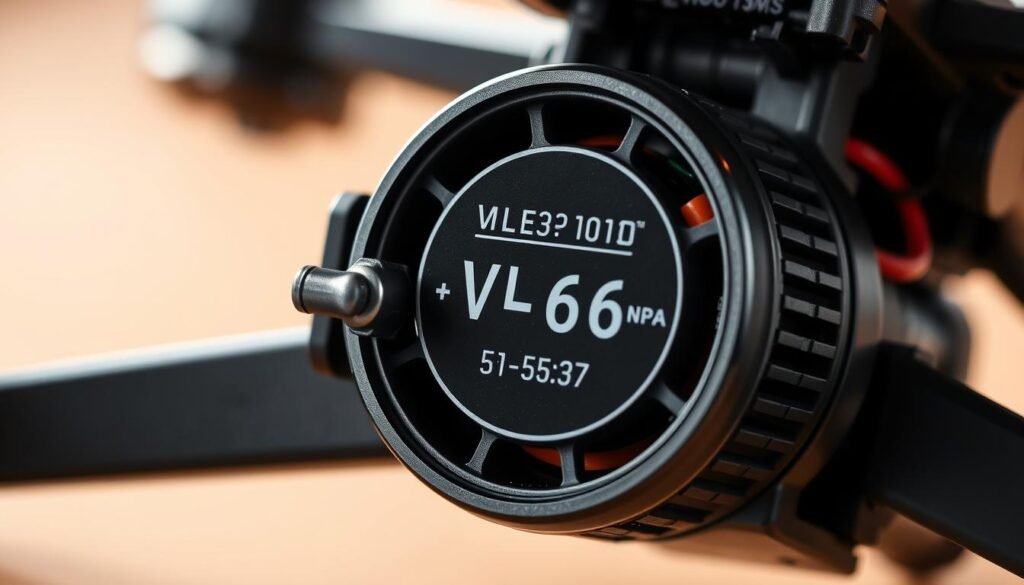
LiPo batteries are popular for their high power-to-weight ratio. The battery’s nominal voltage must match the motor specs for optimal performance. 4S (14.8V) and 6S (22.2V) batteries are common choices.
Battery capacity, measured in mAh, affects flight time. It should balance with the drone’s weight and flight needs. The discharge rate (C-value) impacts power delivery during tough maneuvers.
A 1300mAh LiPo with a 120C discharge rate can deliver 156A max current. This suits high-performance racing and freestyle drones. High discharge rates reduce voltage sag, ensuring smooth power delivery.
| Drone Type | Recommended KV Range | Battery Configuration |
|---|---|---|
| Racing Drone (3″ props or less) | 2500KV to 4000KV | 4S 1500mAh 150C LiPo |
| Medium Quad (4-5″ props) | 1700KV to 2700KV (4S) 2200KV to 2700KV (6S) | 4S or 6S 1300mAh 120C LiPo |
| Heavy-Lift Drone (Cinema Camera) | 450KV to 1050KV | 6S or 8S LiPo |
Matching drone motor specs with compatible LiPo batteries is key for top UAV performance. Consider KV rating, battery voltage, capacity, and discharge rate carefully. This approach will optimize your drone’s power, efficiency, and overall flight quality.
The Role of the ESC in the Drone Motor System
The electronic speed controller (ESC) is crucial for drone motor systems. It regulates power and controls motor speed. ESCs ensure smooth, stable, and responsive drone operations in various conditions.
They convert the battery’s DC power into three-phase AC. This powers brushless motors. ESCs act as intermediaries between the flight controller and motors.
ESCs come in two main types: brushed and brushless. Brushless ESCs are more common in modern drones. They offer better longevity and efficiency for stable, high-speed flight.
Each drone motor needs an independent ESC. The ESC uses a Battery Elimination Circuit (BEC). This powers the flight controller and other electronics.
Power Regulation and Motor Speed Control
ESCs are vital for drone power regulation and motor speed control. They enable smooth acceleration, braking, and directional adjustments. ESC ratings are crucial for compatibility with batteries and motors.
These ratings prevent overloading components. They include current and voltage specifications. Proper ratings ensure safe and efficient drone operation.
| ESC Type | Features | Applications |
|---|---|---|
| Brushed ESCs | Designed for brushed DC motors, limited power | Older or smaller drones |
| Brushless ESCs | Longevity, efficiency, stable and high-speed flight | Modern drones |
| Opto-Isolated ESCs | Optical isolation, protection from electrical interference | High-power setups requiring precise control |
| D-Shot ESCs | Digital protocol, faster response times, reduced signal interference | Drones requiring precise control |
Interpreting Flight Controller Signals
ESCs use serial protocols like PWM, OneShot, or DShot to communicate. DShot offers faster and more reliable communication. It reduces gaps for quick responses and improves energy efficiency.
Advanced ESCs enhance drone performance significantly. They deliver precise control, stability, and responsiveness. This helps achieve stable hovering and agile maneuvers.
Additional Features: Active Braking and Battery Management
Modern ESCs often include active braking and battery management. Active braking allows for quick stops and direction changes. Battery management optimizes power consumption and prevents battery issues.
High-efficiency ESCs optimize energy use. This increases flight time by ensuring motors draw only necessary power. It’s a key factor in drone performance.
ESCs are the unsung heroes of drone motor systems, enabling precise control, stability, and responsiveness for smooth and efficient flight.
Latest Advancements in Drone Motor Technology
Drone motor technology is rapidly advancing. Innovations focus on improving flight performance, motor power density, and control precision. These upgrades are vital for high-performance unmanned aerial vehicles (UAVs) in various industries.
Drone motor innovations now include brushless motors with high magnetic strength. These motors offer increased torque without adding size or weight. The Falcon line by ePropelled provides 1kW to 20kW propulsion systems for UAVs.
ePropelled’s intelligent motor controllers boast up to 98% efficiency. They excel in power management and operational control for various UAV needs.
The UAV propulsion system market is set to grow significantly. Projections show an increase from $6.17 billion in 2024 to $8.19 billion by 2029. This represents a 5.84% compound annual growth rate (CAGR).
Demand is rising for drone propulsion systems up to 20kW and 106V. ePropelled’s Falcon devices are well-suited to meet this need. Electric drone engines are becoming popular for reducing noise in civil and military uses.
Drone motor innovations also focus on improving design, materials, and control algorithms. These changes boost performance and reliability. Brushless DC (BLDC) motors are gaining popularity due to their high efficiency.
BLDC motors often exceed 85% efficiency, outperforming traditional brushed motors. They offer longer lifespans and need less maintenance. This makes them ideal for precision robotics applications.
BLDC motor technology has been crucial in developing aerial drones for various industries. These motors provide high torque at low speeds. This enables precise movements and stable flight.
BLDC motors also dissipate heat well. This ensures consistent performance over long periods, even in tough conditions.
Demand for non-Chinese UAV parts is growing. U.S.-assembled propulsion systems like ePropelled’s are becoming essential globally. China’s export restrictions on systems over 16kW have increased the need for alternatives.
Top Drone Motors on the Market
Choosing the right drone motor is crucial for your UAV’s performance. There are excellent options for various needs. These include industrial, heavy-lift, and high-power drone motors.
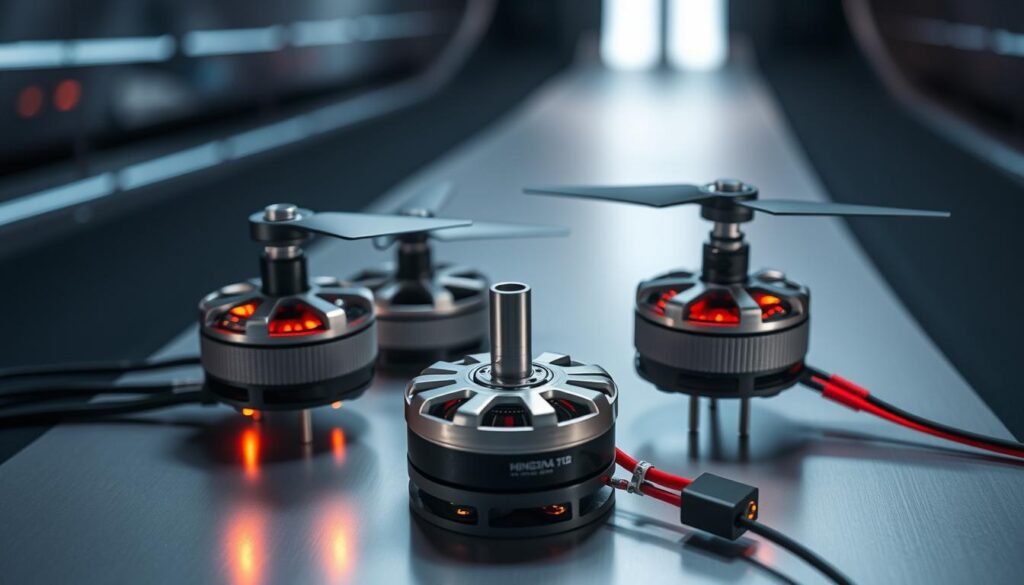
T-MOTOR U15II KV80: Best Industrial Drone Motor with a Maximum Thrust of 36kg
The T-MOTOR U15II KV80 is a top industrial drone motor. It boasts a maximum thrust of 36kg. Its robust build ensures reliable performance in demanding applications.
T-MOTOR U15L KV43: High-Power Motor for Demanding Applications
For high-power drone motors, consider the T-MOTOR U15L KV43. It delivers impressive power output. This motor excels in challenging environments and complex tasks.
T-MOTOR U15XXL KV29: Extreme Performance for Heavy-Lift Drones
The T-MOTOR U15XXL KV29 is a standout heavy-lift drone motor. It offers extreme performance capabilities. This motor enables drones to carry substantial payloads efficiently.
SUPER-E S150: Powerful Motor for Large-Scale UAVs
The SUPER-E S150 is designed for large-scale UAV motors. It provides high torque and efficiency. This motor suits various applications, from aerial photography to industrial inspections.
| Motor | Weight (g) | Rated KV | Tested KV |
|---|---|---|---|
| Brother Hobby Avenger 2806.5 1460 KV | 46 | 1460 | |
| Xnova Freestyle Line 2806.5 | 46.7 | 1300 | ~1150 |
| GEPRC SpeedX2 2806.5 1350 KV | 50.5 | 1350 | ~1350 |
| Emax ECO2 2807 | 54 | – | – |
Plettenberg NOVA 50: High-Speed, High-Power Motor for Advanced Drones
The Plettenberg NOVA 50 is a high-speed, high-power motor. It’s designed for advanced drone motors. This motor is popular among professional pilots and enthusiasts for its exceptional performance.
MGM COMPRO REB 90: Ultra-High-Power Motor for Specialized Applications
The MGM COMPRO REB 90 is ideal for ultra-high power needs. It’s engineered for unparalleled performance. This motor excels in challenging scenarios and cutting-edge drone projects.
Maintenance and Care for Drone Motors
Proper care keeps drone motors running smoothly and efficiently. Regular maintenance reduces unexpected failures and costly repairs. Follow best practices to ensure your motors’ longevity and optimal performance.
Clean your drone motors often to prevent dirt and debris buildup. Use a soft brush or compressed air to remove any accumulation. Strong landing pads help keep dirt away during takeoffs and landings.
Lubricate your motor bearings regularly with high-quality lubricant. This reduces friction and extends motor life. Be careful not to over-lubricate, as it can attract dirt.
Check your motors for wear or damage periodically. Listen for unusual noises like grinding or squeaking. These may indicate bearing problems. Consider bearing replacement if you notice any issues.
“Routine maintenance prevents problems before they arise and keeps costs down. It shifts from reactive to proactive strategies.”
When motor troubleshooting, look for visible damage or loose connections. Test with propellers removed and the drone powered on. Seek professional help if problems persist.
| Maintenance Task | Frequency |
|---|---|
| Motor cleaning | After every 10-15 flights |
| Bearing lubrication | Every 50-100 flight hours |
| Propeller replacement | When damaged or every 100 flights |
| Motor inspection | Before and after each flight |
Make drone motor maintenance a regular part of your routine. This ensures top performance and extends your drone’s life. Consistent care leads to reliable operation and fewer issues.
Choosing the Right Drone Motors for Your Specific Application
Picking the right drone motors is key for top UAV performance. Your choice depends on your drone’s purpose and desired features. The goal is to balance motor power, efficiency, and weight for optimal results.
Frame size matters when selecting application-specific motors. Micro drones need 1105 to 1306 motors. Larger drones require 26XX or bigger motors. Match motor size to frame for best performance.
Brushless motors are typically used in drones due to their superior power-to-weight ratio compared to regular DC motors.
Factors to Consider Based on Your Drone’s Purpose
Your drone’s purpose guides motor selection. Racing drones need speed and agility. High KV motors like 1104, 1204, or 1404 work best for 3″ and 3.5″ drones.
KV ranges vary: 3,000 to 7,000 for 3s setups and 2,500 to 5,000 for 6s configurations. Agricultural drones need powerful, durable motors. Stator sizes from 60mm to 100mm offer various options.
Waterproof motors with IPX6 ratings are vital for agricultural drones exposed to water. They ensure reliable operation in challenging environments.
Balancing Power, Efficiency, and Weight
Striking the right balance is crucial for top drone performance. Powerful motors provide enough thrust for stable flight. However, they can add weight, affecting flight time and agility.
| Motor Size | KV Range | Application |
|---|---|---|
| 0702, 0802, 1002 | 19,000 – 32,000 | Micro Drones |
| 1002, 1003 | – | Toothpick Drones (2″ 1s) |
| 1202.5, 1003 | – | Toothpick Drones (2″ 2s) |
| 1104, 1204, 1404 | 3,000 – 7,000 (3s) 2,500 – 5,000 (6s) | Freestyle & Racing Drones (3″ & 3.5″) |
Consider the power-to-weight ratio and motor efficiency for optimal balance. Efficient motors deliver great performance while saving power. Choose motors that handle your drone’s weight without compromising stability.
Conclusion
Picking the right drone motors is key for top UAV performance. This guide helps you choose wisely. It covers motor types, specs, and factors like pole count and propeller size.
Brushless motors, especially BLDC, are top picks for drones. They’re more efficient and durable than brushed motors. BLDC motors offer smoother flights and better control.
BLDC motors paired with lithium polymer batteries have changed the game. They’ve made drones more agile with longer flight times.
Drone motor tech keeps improving as demand grows. Stay updated on new advances. Think about your drone’s needs when choosing motors.
The right motors can boost your drone’s potential. They open doors in aerial photography, surveying, and inspections. Good motor choice ensures efficient and reliable drone operations.
